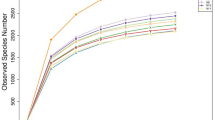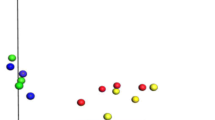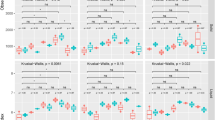Abstract
Rumen microorganisms play an important role in ruminant digestion and absorption of nutrients and have great potential applications in the field of rumen adjusting, food fermentation and biomass utilization etc. In order to investigate the composition of microorganisms in the rumen of camel (Camelus dromedarius), this study delves in the microbial diversity by culture-independent approach. It includes comparison of rumen samples investigated in the present study to other currently available metagenomes to reveal potential differences in rumen microbial systems. Pyrosequencing based metagenomics was applied to analyze phylogenetic and metabolic profiles by MG-RAST, a web based tool. Pyrosequencing of camel rumen sample yielded 8,979,755 nucleotides assembled to 41,905 sequence reads with an average read length of 214 nucleotides. Taxonomic analysis of metagenomic reads indicated Bacteroidetes (55.5 %), Firmicutes (22.7 %) and Proteobacteria (9.2 %) phyla as predominant camel rumen taxa. At a finer phylogenetic resolution, Bacteroides species dominated the camel rumen metagenome. Functional analysis revealed that clustering-based subsystem and carbohydrate metabolism were the most abundant SEED subsystem representing 17 and 13 % of camel metagenome, respectively. A high taxonomic and functional similarity of camel rumen was found with the cow metagenome which is not surprising given the fact that both are mammalian herbivores with similar digestive tract structures and functions. Combined pyrosequencing approach and subsystems-based annotations available in the SEED database allowed us access to understand the metabolic potential of these microbiomes. Altogether, these data suggest that agricultural and animal husbandry practices can impose significant selective pressures on the rumen microbiota regardless of rumen type. The present study provides a baseline for understanding the complexity of camel rumen microbial ecology while also highlighting striking similarities and differences when compared to other animal gastrointestinal environments.







Similar content being viewed by others
Abbreviations
- MG-RAST:
-
Metagenome rapid annotation using subsystem technology
- GS-FLX:
-
Genome sequencer flexible
- SSU:
-
Small subunit
- COG:
-
Clusters of orthologous groups
- KO:
-
KEGG orthology
- NOG:
-
Non-supervised orthologous group
References
Ahmad S, Yaqoob M, Hashmi N, Ahmad S, Zaman MA, Tariq M (2010) Economic importance of camel: unique alternative under crisis. Pak Vet J 30:1–7
Van Soest PJ (1994) Nutritional ecology of the ruminant, 2nd edn. Cornell University Press, Ithaca
Samsudin AA, Paul NE, Andre-Denis GW, Rafat AJ (2011) Molecular diversity of the foregut bacteria community in the dromedary camel (Camelus dromedarius). Environ Microbiol 13:3024–3035
Krause DO, Russell JB (1996) How many ruminal bacteria are there? J Dairy Sci 79:1467–1475
Shin EC, Choi BR, Lim WJ, Hong SY, An CL et al (2004) Phylogenetic analysis of archaea in three fractions of cow rumen based on the 16S rDNA sequence. Anaerobe 10:313–319
Sylvester JT, Karnati SK, Yu Z, Morrison M, Firkins JL (2004) Development of an assay to quantify rumen ciliate protozoal biomass in cows using real-time PCR. J Nutr 134:3378–3384
Kocherginskaya SA, Aminov RI, White BA (2001) Analysis of the rumen bacterial diversity under two different diet conditions using denaturing gradient gel electrophoresis, random sequencing, and statistical ecology approaches. Anaerobe 7:119–134
Handelsman J (2004) Metagenomics: application of genomics to uncultured microorganisms. Microbiol Mole Biol Rev 68:669–685
Edwards RA, Rodriguez BB, Wegley L, Haynes M, Breitbart M et al (2006) Using pyrosequencing to shed light on deep mine microbial ecology. BMC Genomics 7:57–69
Margulies M, Egholm M, Altman WE, Attiya S, Bader JS et al (2005) Genome sequencing in microfabricated high-density picolitre reactors. Nature 437:376–380
Sogin ML, Morrison HG, Huber JA, Welch DM, Huse SM et al (2006) Microbial diversity in the deep sea and the underexplored “rare biosphere”. Proc Natl Acad Sci USA 103:12115–12120
Roesch LF, Fulthorpe RR, Riva A, Casella G, Hadwin AK et al (2007) Pyrosequencing enumerates and contrasts soil microbial diversity. ISME J 1:283–290
Yu Z, Yu M, Morrison M (2006) Improved serial analysis of V1 ribosomalsequence tags (SARST-V1) provides a rapid, comprehensive, sequence-basedcharacterization of bacterial diversity and community composition. Environ Microbiol 8:603–611
Meyer F, Paarmann D, D’Souza M, Olson R, Glass EM et al (2008) The metagenomics RAST server-a public resource for the automatic phylogenetic and functional analysis of metagenomes. BMC Bioinformatics 9:386
Madigan M, Martinko J (2005) Brock biology of microorganisms, 11th edn. Prentice Hall, Upper Saddle River
Dorland WAN (2003) Dorland’s illustrated medical dictionary, 30th edn. W. B. Saunders, Philadelphia
Wexler HM (2007) Bacteroides: the good, the bad, and the nitty-gritty. Clin Microbiol Rev 20:593–621
Xu J, Mahowald A, Ley E, Lozupone A, Hamady M, Martens C, Henrissat B, Coutinho M et al (2007) Evolution of symbiotic bacteria in the distal human intestine. PLoS Biol 5:156
Martens EC, Chiang HC, Gordon JI (2008) Mucosal glycan foraging enhances fitness and transmission of a saccharolytic human gut bacterial symbiont. Cell Host Microbe 13:447–457
Bernhard AE, Katharine GF (2000) A PCR assay to discriminate human and ruminant feces on the basis of host differences in bacteroides-prevotella genes encoding 16S rRNA. Appl Environ Microbiol 66:4571–4574
Kreader CA (1998) Persistence of PCR-detectable bacteroides distasonis from human feces in river water. Appl Environ Microbiol 64:4103–4105
Shipman JA, Cho HK, Siegel HA, Salyers AA (1999) Physiological characterization of SusG, an outer membrane protein essential for starch utilization by Bacteroides thetaiotaomicron. J Bacteriol 181:7206–7211
Jian Xu, Gordon JI (2003) Honor thy symbionts. Proc Natl Acad Sci USA 100:10452–10459
Miron J, Ben-Ghedalia D, Morrison M (2001) Invited review: adhesion mechanisms of rumen cellulolytic bacteria. J Dairy Sci 84:1294–1309
Sung HG, Kobayashi Y, Chang J, Ha A, Hwang H, Ha JK (2007) Low ruminal pH reduces dietary fiber digestion via reduced microbial attachment. Asian-Aust J Anim Sci 20:200–207
Russell JB, Rychlik JL (2001) Factors that alter rumen microbial ecology. Science 292:1119–1122
Ley RE, Hamady M, Lozupone C, Turnbaugh PJ, Ramey RR, Bircher JS, Schlegel ML, Tucker TA, Schrenzel MD, Knight R, Gordon JI (2008) Evolution of mammals and their gut microbes. Science 320:1647–1651
Leser TD, Amenuvor JZ, Jensen TK, Lindecrona RH, Boye M, Moller K (2002) Culture-independent analysis of gut bacteria: the pig gastrointestinal tract microbiota revisited. Appl Environ Microbiol 68:673–690
Qu A, Brulc JM, Wilson MK, Law BF, Theoret JR et al (2008) Comparative metagenomics reveals host specific metavirulomes and horizontal gene transfer elements in the chicken cecum microbiome. PLoS ONE 3:2945
Acknowledgments
Authors are thankful to the LSF Unit, NRCC, Bikaner for the facilities of rumen fluid collection. Authors are thankful to Professor D.S. Nauriyal, who carefully read the early manuscript, corrected some errors, and made many valuable suggestions for improvement.
Conflict of interest
None of the authors has any financial or personal relationships that could inappropriately influence or bias the content of the paper.
Author information
Authors and Affiliations
Corresponding author
Electronic supplementary material
Below is the link to the electronic supplementary material.
Rights and permissions
About this article
Cite this article
Bhatt, V.D., Dande, S.S., Patil, N.V. et al. Molecular analysis of the bacterial microbiome in the forestomach fluid from the dromedary camel (Camelus dromedarius). Mol Biol Rep 40, 3363–3371 (2013). https://doi.org/10.1007/s11033-012-2411-4
Received:
Accepted:
Published:
Issue Date:
DOI: https://doi.org/10.1007/s11033-012-2411-4




